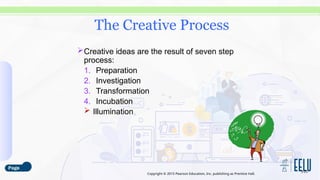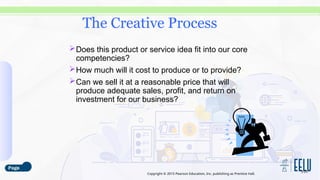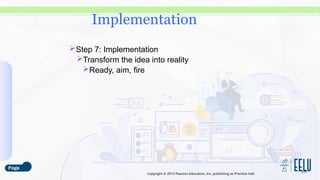creation economic value Chapter 2 - PPT.pptx
- 1. Course Name: Entrepreneurship • Instructor Name: Dr. Heba Elqasaby Semester Number-Fall Academic year: 2023-2024
- 2. Copyright © 2015 Pearson Education, Inc. publishing as Prentice Hall. 3-2 Creativity and Innovation: Keys to Entrepreneurial Success Chapter 2
- 3. Copyright © 2015 Pearson Education, Inc. publishing as Prentice Hall. Creativity: the ability to develop new ideas and to discover new ways of looking at problems and opportunities Thinking new things Innovation: the ability to apply creative solutions to those problems and opportunities to enhance or to enrich people’s lives Doing new things Entrepreneurs succeed by thinking and doing new things or old things in new ways 3-3 Creativity, Innovation, and Entrepreneurship
- 4. Copyright © 2015 Pearson Education, Inc. publishing as Prentice Hall. Intuit identified six enablers of small business innovation: 1. Passion 2. Customer connection 3. Agility and adaptation 4. Experimentation and improvisation 5. Resource limitations 6. Information sharing and collaboration 3-4 Creativity, Innovation, and Entrepreneurship
- 5. Copyright © 2015 Pearson Education, Inc. publishing as Prentice Hall. Innovations can be: Reactive: in response to customer feedback or changing market conditions Proactive: in response to new opportunities on which to capitalize Revolutionary: creating market-changing, disruptive breakthroughs that are the result of generating something from nothing Evolutionary, developing market-sustaining ideas that elaborate on existing products, processes, and services Putting old things together in new ways or from taking something away to create something simpler or better 3-5 Creativity, Innovation, and Entrepreneurship
- 6. Copyright © 2015 Pearson Education, Inc. publishing as Prentice Hall. Entrepreneurs must go beyond relying in what has worked in the past Cast off limiting assumptions, beliefs, and behaviors Develop new insights Change perspectives Look at the world in new and different ways 3-6 Creativity – Essential to Survival
- 7. Copyright © 2015 Pearson Education, Inc. publishing as Prentice Hall. Can Creativity be Taught? Creativity is a skill Anyone can learn to be creative and to get better at it Need to understand creative thinking 3-7 Creativity – Essential to Survival
- 8. Copyright © 2015 Pearson Education, Inc. publishing as Prentice Hall. Each hemisphere of the brain processes information differently One side tends to be dominant The left brain handles language, logic, and symbols Thinking is narrowly focused and systematic The right brain handles emotional, intuitive, and spatial functions Thinking is unconventional, unsystematic, and unstructured 3-8 Creative Thinking
- 9. Copyright © 2015 Pearson Education, Inc. publishing as Prentice Hall. Right brain, lateral thinking is at the heart of the creative process Individuals can learn to control which side of the brain is dominant in a given situation Can learn to ‘turn down’ the dominant left side and ‘turn up’ the right side Successful entrepreneurs need both left and right side thinking The right side generates innovative ideas The left side judges market potential 3-9 Creative Thinking
- 10. Copyright © 2015 Pearson Education, Inc. publishing as Prentice Hall. Mental locks that can limit individual creativity: 1. Searching for the one “right” answer 2. Focusing on “being logical” 3. Blindly following the rules 4. Constantly being practical 5. Viewing laughter and play as frivolous 6. Becoming overly specialized 7. Avoiding ambiguity 8. Fearing looking foolish 9. Fearing mistakes and failure 10.Believing that “I’m not creative” 3-10 Barriers to Creativity
- 11. Copyright © 2015 Pearson Education, Inc. publishing as Prentice Hall. Enhancing Organizational Creativity 1. Include creativity as a core company value and make it an integral part of the company’s culture 2. Hire for creativity 3. Embrace diversity 4. Establish an organizational structure that nourishes creativity 5. Expect creativity 6. Expect failure and learn from it 7. Incorporate fun into the work environment 8. Encourage curiosity 9. Design a workspace that encourages creativity 3-11 How to Enhance Creativity
- 12. Copyright © 2015 Pearson Education, Inc. publishing as Prentice Hall. 10.View problems as opportunities 11. Provide creativity training 12.Provide support 13.Develop a procedure for capturing ideas 14.Talk with customers – or better yet, interact with them 15.Monitor emerging trends and identify ways your company can capitalize on them 16.Look for uses for your company’s products or services in other markets 17.Reward creativity 18.Model creativity 3-12 How to Enhance Creativity
- 13. Copyright © 2015 Pearson Education, Inc. publishing as Prentice Hall. Enhancing Individual Creativity 1. Allow yourself to be creative 2. Forget the “rules” 3. Give your mind fresh input everyday 4. Travel – and observe 5. Collaborate with other people 6. Observe the products and services of other companies, especially those in different markets 7. Recognize the creative power of mistakes and accidents 3-13 How to Enhance Creativity
- 14. Copyright © 2015 Pearson Education, Inc. publishing as Prentice Hall. 8. Be positive 9. Notice what is missing 10.Periodically ask yourself, “Am I asking the right question?” 11. Keep a journal handy to record your thoughts and ideas 12.Listen to other people 13.Get adequate sleep 14.Watch a movie 15.Talk to a child 3-14 How to Enhance Creativity
- 15. Copyright © 2015 Pearson Education, Inc. publishing as Prentice Hall. 16.Do something ordinary in an unusual way 17.Keep a toy box in your office 18.Take note of your ‘pain points’: do other people experience them as well? 19.Do not throw away seemingly ‘bad’ ideas 20.Read books on stimulating creativity or take a class on creativity 21.Take some time off 22.Be persistent 3-15 How to Enhance Creativity
- 16. Copyright © 2015 Pearson Education, Inc. publishing as Prentice Hall. Creative ideas are the result of seven step process: 1. Preparation 2. Investigation 3. Transformation 4. Incubation 5. Illumination 6. Verification 7. Implementation 3-16 The Creative Process
- 17. Copyright © 2015 Pearson Education, Inc. publishing as Prentice Hall. Step 1: Preparation Adopt the attitude of a lifelong student Read—a lot—and not just in your field of expertise Clip articles of interest to you and create a file for them Take time to discuss your ideas with other people, including those who know little about it as well as experts in the field Join professional or trade associations and attend their meetings Develop listening skills. Eliminate creative distractions 3-17 The Creative Process
- 18. Copyright © 2015 Pearson Education, Inc. publishing as Prentice Hall. Creative ideas are the result of seven step process: 1. Preparation Investigation 3-18 The Creative Process
- 19. Copyright © 2015 Pearson Education, Inc. publishing as Prentice Hall. Step 2: Investigation Develop a solid understanding of the problem, situation, or decision at hand 3-19 The Creative Process
- 20. Copyright © 2015 Pearson Education, Inc. publishing as Prentice Hall. Creative ideas are the result of seven step process: 1. Preparation 2. Investigation Transformation 3-20 The Creative Process
- 21. Copyright © 2015 Pearson Education, Inc. publishing as Prentice Hall. Step 3: Transformation Two types of thinking: 1. Convergent thinking: the ability to see the similarities and the connections among various and often diverse data and events 2. Divergent thinking: the ability to see the differences among various data and events 3-21 The Creative Process
- 22. Copyright © 2015 Pearson Education, Inc. publishing as Prentice Hall. Transforming information into a purposeful idea: Evaluate the parts of the situation several times, trying to grasp the big picture Rearrange the elements of the situation Try using synectics (a term derived from the Greek words for “to bring together” and “diversity”),taking two seemingly nonsensical ideas and combining them Before locking into one particular approach to a situation, remember that several approaches might be successful 3-22 The Creative Process
- 23. Copyright © 2015 Pearson Education, Inc. publishing as Prentice Hall. Creative ideas are the result of seven step process: 1. Preparation 2. Investigation 3. Transformation Incubation 3-23 The Creative Process
- 24. Copyright © 2015 Pearson Education, Inc. publishing as Prentice Hall. Step 4: Incubation Ideas may require a gestation period Walk away from the situation Take the time to daydream Relax – and play - regularly Dream about the problem or opportunity Work on the problem or opportunity in a different environment 3-24 The Creative Process
- 25. Copyright © 2015 Pearson Education, Inc. publishing as Prentice Hall. Creative ideas are the result of seven step process: 1. Preparation 2. Investigation 3. Transformation 4. Incubation Illumination 3-25 The Creative Process
- 26. Copyright © 2015 Pearson Education, Inc. publishing as Prentice Hall. Step 5: Illumination The light bulb goes on 3-26 The Creative Process
- 27. Copyright © 2015 Pearson Education, Inc. publishing as Prentice Hall. Creative ideas are the result of seven step process: 1. Preparation 2. Investigation 3. Transformation 4. Incubation 5. Illumination Verification 3-27 The Creative Process
- 28. Copyright © 2015 Pearson Education, Inc. publishing as Prentice Hall. Step 6: Verification Is it really a better solution to a particular problem or opportunity? Will it work? Is there a need for it? Is there a need for it? If so, what is the best application of this idea in the marketplace? 3-28 The Creative Process
- 29. Copyright © 2015 Pearson Education, Inc. publishing as Prentice Hall. Does this product or service idea fit into our core competencies? How much will it cost to produce or to provide? Can we sell it at a reasonable price that will produce adequate sales, profit, and return on investment for our business? 3-29 The Creative Process
- 30. Copyright © 2015 Pearson Education, Inc. publishing as Prentice Hall. Creative ideas are the result of seven step process: 1. Preparation 2. Investigation 3. Transformation 4. Incubation 5. Illumination 6. Verification Implementation 3-30 The Creative Process
- 31. Copyright © 2015 Pearson Education, Inc. publishing as Prentice Hall. Step 7: Implementation Transform the idea into reality Ready, aim, fire 3-31 Implementation































